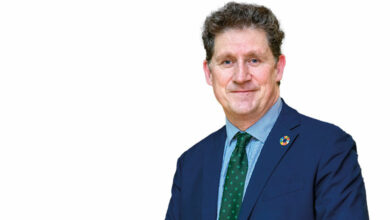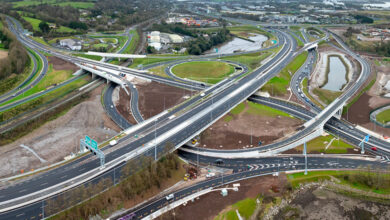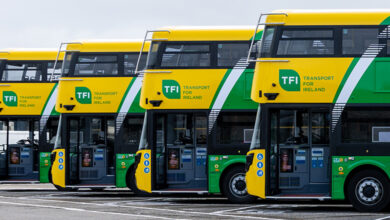Transdev Dublin Light Rail: A track record of delivery
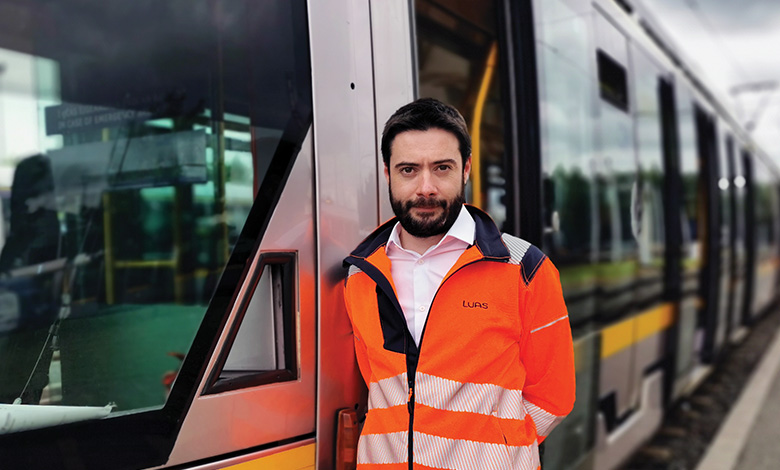
Marking 20 years of operating and maintaining Luas in Dublin, Eoghan Sweeney, Deputy Managing Director and Dave Rooney, Director of Operations with Transdev Dublin Light Rail (TDLR) speak with eolas Magazine about post-pandemic recovery, recruitment, and network extension.
Luas was launched in Dublin with the opening of the green line on 30 June 2004 followed by the red line three months later on 26 September. Following the official opening, 430,000 passengers availed of four days of free travel. Then-Minister for Transport, the late Séamus Brennan, remarked: “Today, Luas returned a tram service to Dublin, 45 years since it finished. It reflects a new vibrant Dublin and the country as a whole.” Brennan’s comments proved prescient.
Reflecting on this 20-year journey, the Deputy Managing Director expresses his pride that Transdev has operated and recently maintained the Luas for the entirety of its existence. “Luas has been hugely successful due to the really positive delivery by Transdev, with total passenger journeys increasing in 12 out of the 20 years,” Sweeney says, adding: “Today, one-in-five public transport journeys in Dublin are now taken via Luas, exceeding all targets that we had initially set.”
“Transdev is a great business to grow in.” Rooney observes, adding: “In fact, the driver of the very first tram in passenger service, Eddie Byrne, remains with the business today as a senior trainer.”
Having originally worked as a traffic supervisor in 2004, Rooney himself now sits in the same control room, as Operations Director. Likewise, Sweeney started his Transdev career interning as an infrastructure and vehicle maintenance coordinator in 2010.
Remarking on the low turnover of staff in Transdev – many of whom, like himself, have been with the company for 20 years – Rooney attributes this to the close relationships TDLR cultivates. “We are very much a trusted partner, not only with our clients, but also with the communities in which we operate and our staff, many of whom emanate from those communities.
“There is very much a family atmosphere within TDLR. It is palpable. Visitors to our Red Cow depot often remark on the huge enthusiasm exhibited by our people, both for light rail itself and for what we do: moving people. That is our defining mission.”
Agreeing with this assessment, Sweeney adds: “With an average of 150,000 passenger journeys delivered each day, everyone here is incredibly proud to work for Transdev and Luas to deliver that service.”
20th anniversary
Marking 20 years of TDLR and Luas in Dublin, the Minister for Transport will meet with Transdev, Transport Infrastructure Ireland, and the National Transport Authority for a celebration event at the St Stephen’s Green Luas stop on 30 June 2024. Internally then, TDLR will run a series of events to celebrate the last 20 years.
However, cognisant that the continued pursuit of its mission comes first, TDLR is not resting on its laurels. In fact, the day before the anniversary, 29 June, will be the busiest day in the Luas calendar year. “With the Dublin LGBTQ Pride parade coinciding with several other public events, we will carry in excess of 150,000 people in one day. After that we can celebrate,” says Sweeney.
Community engagement
With more than 400,000 people living within 1km of its network, Luas serves communities across Dublin – north, south, east, and west. Transdev is cognisant that public transport networks can act as a catalyst for environmental, economic, and social development.
As such, through its wider community engagement programme, TDLR seeks to support some of Dublin’s most disadvantaged communities through partnerships with Fettercairn Community, Ballyogan, and St Patrick’s Athletic Football Club, as well as 16 local schools.
“We have an ongoing project there with St Pat’s Athletic and the Football Association of Ireland whereby we educate young people about the Luas and its benefits, and also supporting them in their education and career journeys. For instance, we facilitate work experience and conduct mock interviews.
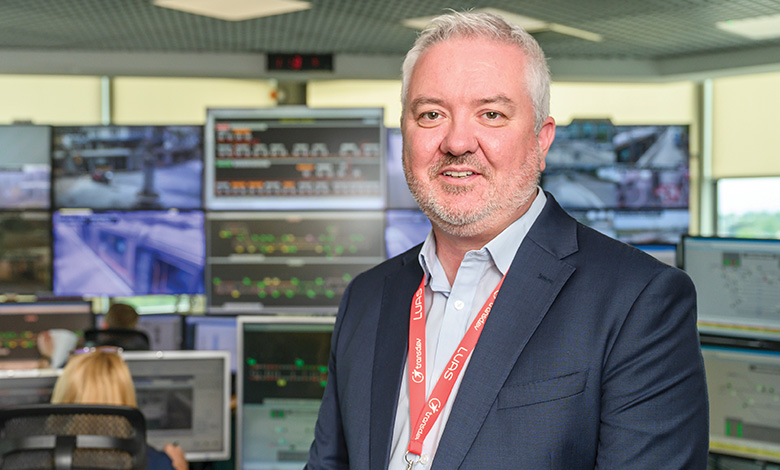
“TDLR recognises that for public transport to be a viable option for people in the Greater Dublin Area, it must be seamless.”
Dave Rooney, Director of Operations, Transdev Dublin Light Rail
“Likewise, when partnering with Business in the Community Ireland’s Skills @ Work Programme, TDLR linked with St Aidan’s Community School in Tallaght. The programme comprised a series of workshops held in the Red Cow Luas depot, providing insight into how we operate, the experience of a typical working day, and how to prepare to leave education,” Sweeney outlines.
International footprint
Operating in 19 countries across five continents, Transdev employs over 100,000 people and is the leading operator and maintainer of light rail systems globally. “TDLR can draw on that expertise at any time if there is a challenge or a technical issue,” Sweeney explains.
“In 2022, for instance, as part of our business transformation we deployed 15 international experts across Dublin in support of Luas delivery. On the other hand, networks such as Sydney Light Rail have learnt a lot from Luas. Indeed, Brian Brennan, a previous Managing Director of TDLR is now the CEO of Transdev Australasia. It is a virtuous circle.”
Emphasising the role of this international experience and the support of the wider Transdev Group, the Operations Director believes that Luas would not have achieved the same level of success it enjoys today.
“Joining a company like Transdev, which has a significant international footprint of light railway operations elsewhere in the world and bringing a tram system back to Dublin after a 45-year absence was an incredible experience,” Rooney concurs.
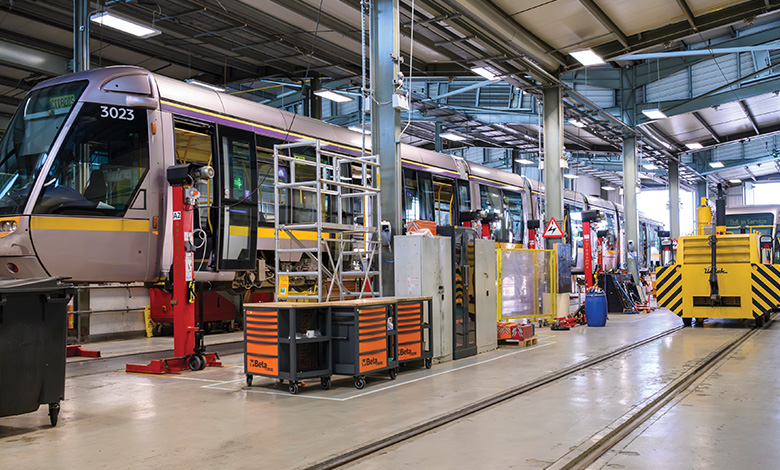
“We are second only to Dublin Bus when it comes to total passenger journeys taken on the island of Ireland.”
Eoghan Sweeney, Deputy Managing Director, Transdev Dublin Light Rail
Post-pandemic recovery
The Covid pandemic had a significant impact on Luas services. In 2023, however, a total of 48.2 million passenger journeys signalled a return to the pre-Covid 2019 peak “well ahead” of other European light rail transit (LRT) systems.
Conceding that the Covid pandemic was “quite a challenging time” for TDLR, Sweeney emphasises that “we continued to deliver Luas services for essential workers throughout that time”. Emerging from the pandemic, Transdev Ireland then launched a comprehensive business transformation strategy.
“We transformed the business,” he asserts, adding: “This ensured that we delivered across each of our metrics, and we are now exceeding our performance targets.”
TDRL has also responded to the new post-Covid travel patterns which have resulted in “increased off-peak and weekend travel”. “We have responded by reviewing the frequency of services in the evenings and at weekends and are set to implement these changes later in 2024,” Sweeney states.
Recruitment
Post-Covid, recruitment also became a major priority for Transdev Ireland. With increased activity in maintenance alongside three major overhauls in the Luas fleet, TDLR recruited more than 150 staff between 2022 and 2023, bringing the net total to over 650. However, in a tight labour market, achieving this was a challenge.
“Previously, Transdev Ireland had a bank of applications from prospective drivers and maintenance technicians on file. Now, with the economy operating at virtually full employment, we have had to recruit elsewhere due to a talent shortage in the State,” Sweeney explains.
Success
Overall, while Luas came under intense scrutiny prior to its launch in 2004, the project has been a runaway success in terms of passenger growth. That popularity brings its own challenges, and while the initial trams were 30 metres in length, today the trams on the green line are among the longest in the world at 50 metres in length.
“As the economy has grown, more people need to move around Dublin. Luas is now the heavy lifter when it comes to moving those people. In fact, with a relatively small footprint, we are second only to Dublin Bus when it comes to total passenger journeys taken on the island of Ireland,” Sweeney indicates.
Discussing the success of the Luas, Rooney remarks on its global reputation. “One thing people probably do not realise about the light rail tram system in Dublin it is how well regarded it is internationally, among other public transport authorities.
“For example, if we compare Luas to Manchester Metrolink – which is twice as large in terms of track, rolling stock, and stations – we are carrying significantly more passengers each year.
“Similarly, many people will be unaware that at peak hours we carry as many as 400 people on a single green line tram. Running at a peak frequency, that is the equivalent of a Boeing 747 landing at St Stephen’s Green every three minutes. Luas demonstrates an unrivalled ability to move people across Dublin, especially when compared to other modes of transport.”
Network extension
Commenting on TDLR’s “proven track record” in delivery network extension, Rooney references the period between 2009 and 2011 when three major extensions to the Luas network took place within 18 months.
“That type of delivery is complex. It involves significant collaboration with clients to support system integration and testing. It also requires recruitment of drivers, engineers, and maintenance technicians to service the additional fleet,” he says.
Indeed, the Deputy Managing Director stresses that the success of the Luas network extensions to date “would not have been possible if we did not work in a partnership with our clients, with other transport providers, local authorities, and with the emergency services”.

“We are a partner in terms of public transport delivery in Dublin. In TDLR, public service takes primacy. That, to me, is one of our unique selling points,” Sweeney says.
Reinforcing this theme, the Operations Director notes that “we work very closely the other public transport operators in the State”.
“TDLR recognises that for public transport to be a viable option for people in the Greater Dublin Area, it must be seamless. In Dublin, each of the operators exhibit that ability to collaborate to achieve this,” Rooney says.
Further planned extensions to the network include Luas Finglas, which is expected to enter operation between five and seven years from now, followed by Luas Lucan. At the same time, Transport Infrastructure Ireland (TII) is in the process of procuring a new fleet of trams to replace those currently in operation on the red line.
Luas Cross City experience
Previously, Sweeney had served as department manager for the Luas Cross City extension to the green line. “Towards the end of the construction phase, TDLR began mobilising the extension. That meant commissioning and stress testing the installed systems followed by tests with rolling stock. We brought trams through the system to ensure all functions were working as designed. After running the frequency and headway that the system had been designed for, we then began comprehensive training along the new route for every single driver.
“The challenge of Luas Cross City was cutting through the heart of city, particularly around historic areas of the city. That was a technical challenge. As such, much of the work was completed and assessed overnight,” he recalls.
While its construction was disruptive to the city, Luas Cross City was opened ahead of schedule and on budget. “Like the original system it was massively successful from day one and it really changed the system. Beforehand, we had two light rail lines with a short walk between them. Now, we have a tram network with people beginning journeys on the red line and completing them on the green line. The use of those connections has been a massive transformation.”
Following its opening, customer satisfaction with the new network exceeded 90 per cent. “Traditionally, the Luas has topped the Transport for Ireland customer satisfaction surveys ahead of other modes of transport. That is something to be proud of, though we cannot take it for granted. We work every day to ensure that we deliver the best possible service with the network we have in place,” observes Rooney.
Vision
Discussing the TDLR vision from an operations perspective, Rooney emphasises service quality. “Our priority is to deliver the quality of service that our customers expect while simultaneously supporting TII to surpass the 50 million passenger per annum mark, an objective we expect to achieve in 2024.
“If we continue to deliver a reliable, frequent, and safe service as well as we have done, then we will continue to grow passenger numbers,” Rooney concludes.
Taking a longer-term view, Ben Dwars, CEO, TDLR, states that he is “looking forward to the future network growth, the introduction of the new red line fleet, maintenance, and digital enhancements which will deliver for Luas passengers and Dublin city an excellent customer experience”.
“With passenger numbers continuing to grow alongside the planned expansion of the network, our organisation will also grow and likely double over the next 20 years. We are looking forward to embracing this growth and delivering a high-quality light rail service in Dublin for the next 20 years,” Sweeney summarises.
For more information:
Transdev Dublin Light Rail,
Luas Depot, Clondalkin, D22 C5P3
T: 014614910


